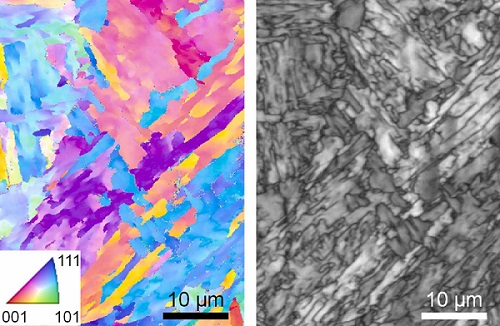
3D Printing Tackles One of the Strongest Stainless Steels
A team from the National Institute of Standards and Technology (NIST), the University of Wisconsin-Madison (UW-Madison), and Argonne National Laboratory have 3D-printed a variety of stainless steel that is favored for its high strength and corrosion resistance. The alloy, called 17-4 precipitation hardening (PH) stainless steel, is used in airliners, cargo ships, nuclear power plants, and other critical technologies.
The team reports that, for the first time, the material can be consistently printed while retaining its favorable characteristics. The researchers identified 17-4 steel compositions that, when printed, match the properties of the conventionally manufactured versions. The printing strategy was developed using high-speed data about the printing process obtained using high-energy x-rays from a particle accelerator.

Microscopic images of 3D-printed 17-4 stainless steel. The colors in the version on the left represent the differing orientations of crystals within the alloy. Courtesy of NIST.
The team’s findings could help producers of 17-4 PH parts use 3D printing to cut costs and increase their manufacturing flexibility. The approach used to examine the material in this study may also set the table for a better understanding of how to print other types of materials and predict their properties and performance.
Despite its advantages over conventional manufacturing, 3D printing of some materials can produce results too inconsistent for certain applications. Printing metal is particularly complicated — in part because of the rapid temperature shifts the materials undergo during the process.
Additive manufacturing of metals welds millions of tiny, powdered particles into one piece using a high-power source like a laser — melting them into a liquid and cooling them into a solid, according to NIST physicist Fan Zhang, a co-author of the study. The cooling rate, he said, is high, sometimes higher than a million degrees Celsius per second. This extreme nonequilibrium condition creates a set of extraordinary measurement challenges.
Because the material heats and cools so quickly, the arrangement — or crystal structure — of the atoms changes rapidly and can be difficult to pin down, Zhang said. Without understanding what’s happening to the crystal structure of the steel as it’s being printed, researchers have struggled for years to 3D print 17-4 PH, in which the crystal structure must be just right — a type called martensite — for the material to exhibit its highly sought-after properties.
The team sought to uncover what happens during those quick temperature changes and to find a way to drive the internal structure toward martensite.
To do this, the researchers turned to synchrotron x-ray diffraction (XRD). According to Lianyi Chen, a professor of mechanical engineering at UW-Madison and study co-author, in XRD, x-rays interact with a material and will form a signal that is like a fingerprint corresponding to the material’s specific crystal structure.
Using the Advanced Photon Source, the 1100-m-long particle accelerator at Argonne National Laboratory, the researchers bombarded steel samples with high-energy x-rays during printing. The team mapped out changes in the crystal structure over the course of a print, revealing how certain factors they could control — such as the composition of the powdered metal — influenced the process throughout.
Although iron is the primary component of 17-4 PH steel, the composition of the alloy can contain differing amounts of up to a dozen different chemical elements. The authors, now equipped with a clear picture of the structural dynamics during printing as a guide, fine-tuned the makeup of the steel to find a set of compositions including just iron, nickel, copper, niobium, and chromium that did the trick.
“Composition control is truly the key to 3D-printing alloys. By controlling the composition, we are able to control how it solidifies. We also showed that, over a wide range of cooling rates, say between 1000 and 10 million Celsius per second, our compositions consistently result in fully martensitic 17-4 PH steel,” Zhang said.
Some compositions, they found, resulted in the formation of strength-inducing nanoparticles that, with the traditional method, require the steel to be cooled and then reheated. In other words, 3D printing could allow manufacturers to skip a step that requires special equipment, additional time, and higher production costs.
Mechanical testing showed that the 3D-printed steel, with its martensite structure and strength-inducing nanoparticles, matched the strength of steel produced through conventional means.
The findings could have implications beyond 17-4 PH steel. Not only could the XRD-based approach be applied to optimize other alloys for 3D printing, but the information it reveals could also be useful in building and testing computer models meant to predict the quality of printed parts.
Additionally, according to Chen, the team’s 17-4 is reproduceable, which lowers the barrier for commercial use.
The research was published in Additive Manufacturing (www.doi.org/10.1016/j.addma.2022.103068).
Published: September 2022